Battery charging NiMH
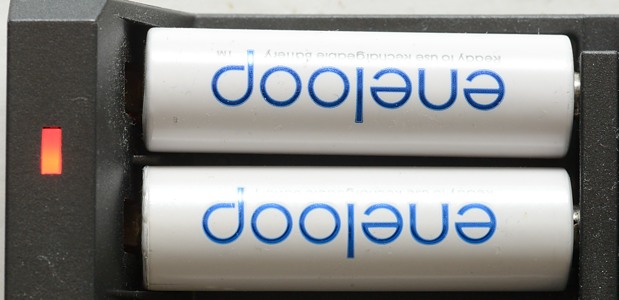
This article will look at the different charge and termination metodes for NiMH batteries, their advantages and disadvantages, last I will show some detailed measurements from charging NiMH cells.
Generally about charging
AA/AAA NiMH batteries are usual rated for charging up to 1C, i.e. same current as their capacity. This means that a charge current of 2000mA (or 2A) for a 2000mAh battery, most chargers will charge with a lower current, but there is also some chargers that uses higher current.
A high charge current will usual reduce the number of charge cycles a battery can last, i.e. using a lower charge current will mean longer battery life.
But using a low charge current has its own problems, detecting when a NiMH battery is full can be problematic and overcharging will also reduce the life of the battery, especially LSD (Low Self Discharge) types.
One way around this problem is using the battery voltage for termination, it works, but has a few problems because it varies with temperature and actual chemical composition of the battery, i.e. not all brands needs exactly the same termination voltage. If the termination voltage in the charger is a too high the charger may never terminate and will overcharge the battery in a serious way. If the termination voltage is too low, the charger will stop premature and you will get a battery with a bit less than full capacity. This can be fixed with a top-off charge, i.e. a lower current charge for a fixed time (like 1-2 hours), this will probably overcharge the battery, but with a low current and for a limited time, i.e. damage will be minor.
Long ago when battery chemistry was NiCd there was a problem with self-discharge, to prevent that chargers would usual use a trickle charge when finished, i.e. continue to charge with a low current. Generally this current was low enough to not do any damage to NiCd batteries.
Then NiMH shows up, the do also have some self-discharge, but much less. Again trickle charge can be used, but to make chargers work for both NiCd and NiMH this trickle charge is usual considerable higher than NiMH needs, but they can mostly take it.
Next improvement in batteries is NiMH LSD, they have basically no self-discharge and do not need any trickle charge and will be slowly damaged by it. As long as the batteries are removed when the charger is finished (or within an hour or two) it is not really a problem, but letting the batteries stay in a charger with a high trickle charge will wear them down.
Some charger will combine different termination methods, this makes it fairly safe that it will always terminate.
Low current charging
Some very cheap chargers do not have any electronic in them and just charges with a low current as long as there are batteries in it. This is not a good way to maintain batteries, but it might be useful for batteries that is nearly worn down and for that reason is rejected by a smarter charger.
%20%231.png)
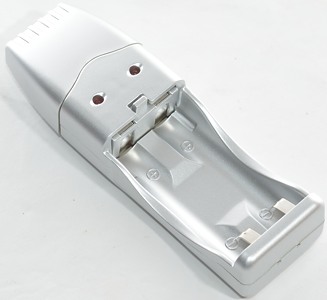
The battery is full shortly after the voltage increase, but the charger continues to charge until I decides to stop.
Timed charging
An improvement on the low current charging is to add a timer, i.e. the charger will stop after a fixed time. When using this type of charger it is a good idea always to start with empty batteries, then the overcharge will be as low as possible. This type of charger does often charge batteries in series, i.e. you need to put two batteries in the charger before it will charge. Because the charging is on time both batteries in a series will always be fully charged and probably overcharged.
%2012.png)
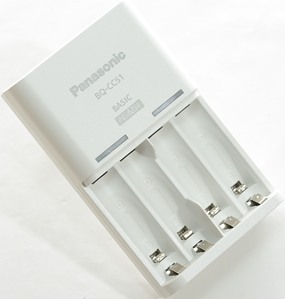
The battery is full shortly after the voltage increase, but the charger continues to charge until a fixed time, with this charger it is 750 minutes.
Voltage termination
This method is popular in low current chargers and in analyzers, because it works at lower currents.
One advantage with voltage termination is very fast detection of full batteries
%20%231.png)
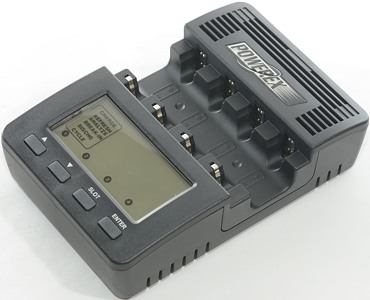
The charger charges until the voltage increases, then it changes to a top-off charge for two hours. The battery is reported ready when the main charge stops.
%20%231.png)
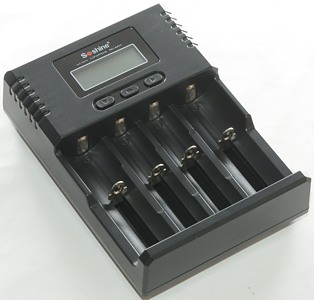
This charger also charges until the voltage increases, then it switches to trickle charge, but it is missing a top-off charge.
-dv/dt termination
This is one of the best ways to termination a NiMH charge, but it is not without its problems. The charger current must be high enough or there will not be a -dv/dt signal to terminate on, i.e. a analyzer with -dv/dt termination would probably miss termination at low current settings.
There is also a problem when starting, when the battery gets warmed from the charge current it might look like a -dv/dt termination, to avoid this it is recommended never to terminate the first 10 minutes during charging, i.e. detecting of full batteries will be slow.
-Charge.png)
I have not seen a charger using non pulsing -dv/dt termination, this chart is from my test equipment.
-dv/dt termination pulsing
Real world -dv/dt chargers uses pulsing current when charging, probably because there is less noise in the voltage measurement with the charge current off.
%20%231.png)
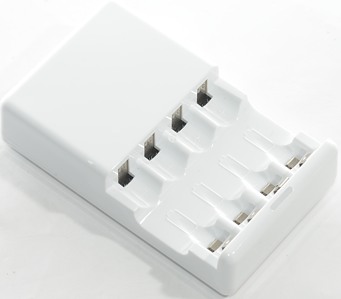
The voltage rises and the drops a bit, before the charger stops, this is a typical -dv/dt charge termination.
0dv/dt termination
-dv/dt termination only works at higher charge current (see below), when the charge current is lower the voltage drops disappears. Instead of looking for a voltage drop, it is possible to look for a steady voltage (or maybe even a very slowly raising voltage) and use that as termination.
It can be used as supplement to -dv/dt termination to improve termination detection. I.e. the charger stops if the voltage drops or stays steady for some time.
.png)
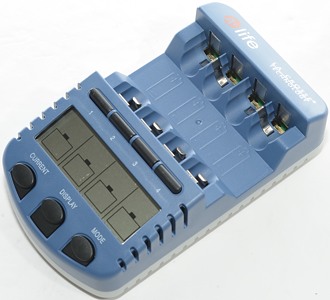
It is often difficult to see if the termination is -dv/dt or 0dv/dt, with this charger only using 200mA charge current and no obvious drop in voltage, it probably is 0dv/dt termination.
dT/dt termination (Temperature raise)
I have not seen any chargers using temperature termination, but usual it is a good indicator the battery is full.
In my reviews I often include a temperature track (Black line) with NiMH batteries and assume they are full when the temperature raises.
Temperature termination
A charger can also stop on a specific temperature, this is not as precise as looking for a temperature raise, but can be used to stop if something is wrong.
Some chargers uses it to pause the charging, waiting for the charger and battery to cool down. This is not because the battery develops heat, it is the charger that generates the heat.
.png)

This charger takes 3 breaks during charging to cool down (Heat is often a problem with this compact charger type).
Smart termination
Not all chargers follows the terminations show above, they do something else that also works and can work better than the above.
%20%231.png)
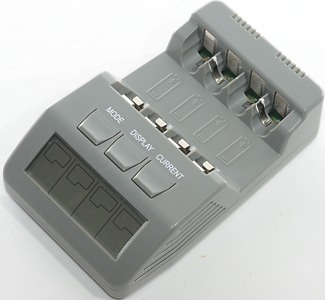
This charger reduces the charge current when the charge is nearly finished, this keeps the battery cooler (Very nice) and then it terminates when the temperature starts raising, i.e. when the battery is full, but at 200mA charge current it cannot be a -dv/dt termination and it does not terminate at a fixed voltage. This charger could be using dT/dt termination, but the temperature sensor is common for two batteries, it is more likely it is 0dv/dt or something else.
Charging in series
Many chargers can only charge two or four batteries at a time, this means they are charging them in series and cannot control how much charge is filled into each battery.
For a timer based charging this is not really important, it will always overcharge both cells.
For a charger with smarter termination it is a problem if the cells starts at different charge state.
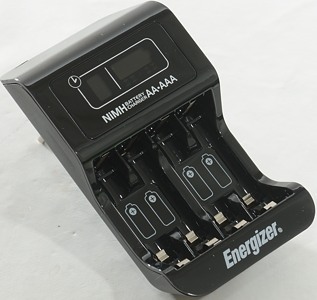
With this charger you can get one overcharged cell and one half full cell if you start with an empty and a full cell. It is not the best way to get a long life from the cells.
A close look at -dv/dt termination
I programmed some of my equipment to simulate a charger and did some detailed measurement during charge. I did not terminate the charge, because I wanted to see how the curve would look.
Because chargers usual turn current off when measuring voltage, I did the same, but measured voltage with both current on and off.
The battery was placed away from the equipment, i.e. any temperature raise is only due to the battery and not any heating from equipment.
The battery I am using is a 2000mAh eneloop that is a few years old and has been used a lot.
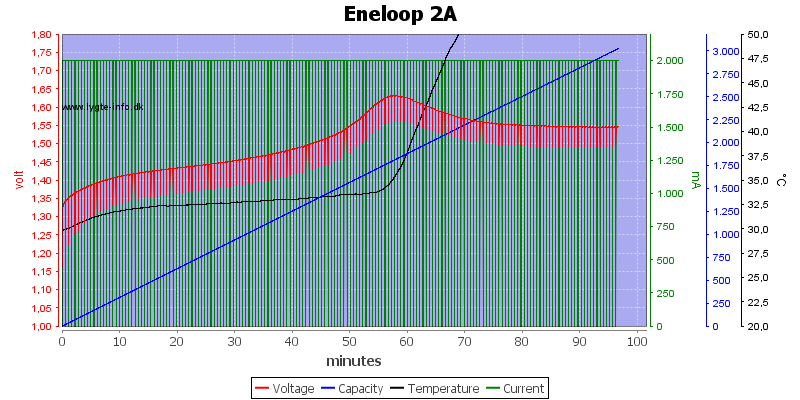
First curve is with 2A charge current, i.e. a rather fast charger.

The voltage drop is large and very easy to detect, with or without current.

Second curve is a 1A charge curve, the voltage raise and then voltage drop when the cell is full is very easy to see, same with temperature raise.
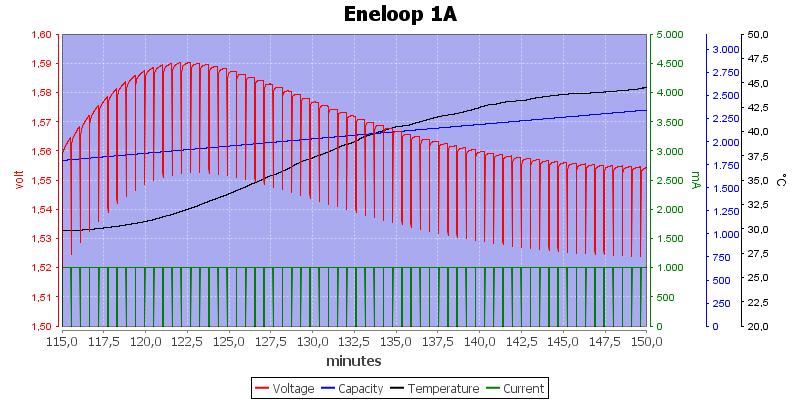
Lets look a bit closer at the voltage peak. It is up to 1.590 volt with current on and 1.552 volt with current off. 5 minutes later the voltages are 1.583 with current and 1.548 without current, i.e. a drop of 7mV with current and 4mV without current.
Lets try 10 minutes: 1.570 volt and 1.539 volt, i.e. 20mV and 13mV, again the best signal when measured with current on.
The reason chargers measures with current off is probably due to noise, the signal may be less, but with current turned off the noise is also reduced.
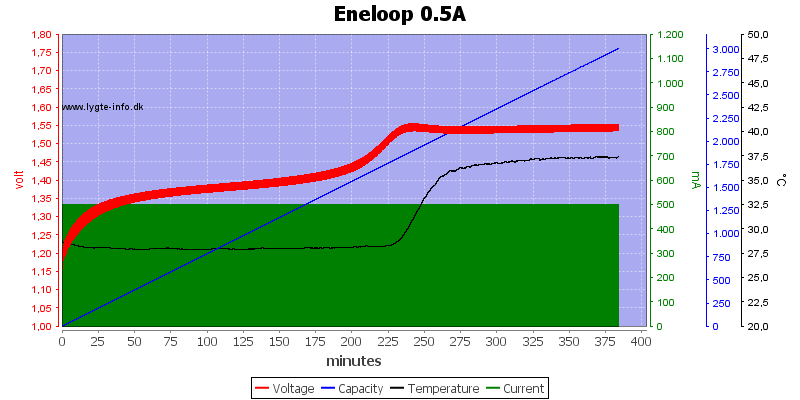
Next test is with lower charge current, how much signal do we get here.
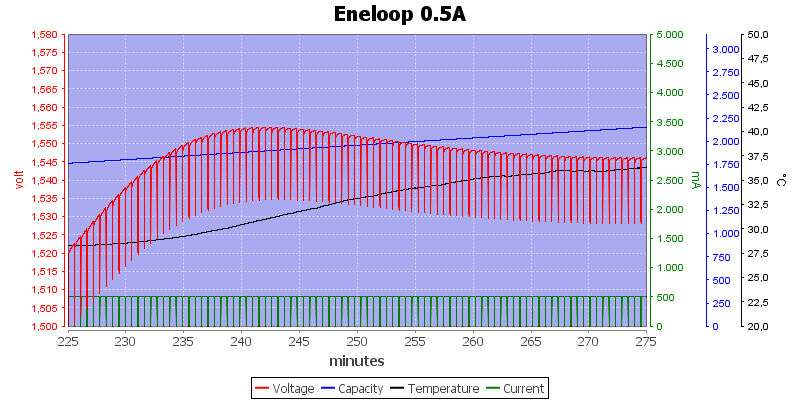
The voltage peak is 1.555 volt with current and 1.535 without current, about 10 minutes later we have 1.551 and 1.532, this means a drop of 4mV and 3mV, this is not much voltage to termination on. One solution is to wait a bit more time.
At 20 minutes the voltages are 1.547 and 1.529, the drops are then 8mV and 6mV, this is better.
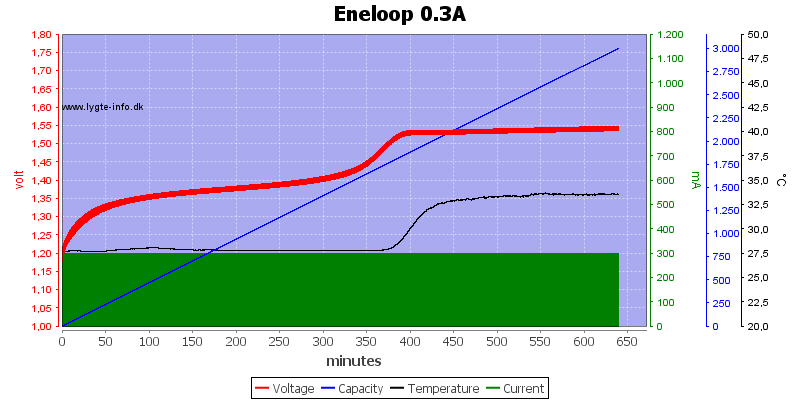
Stepping the current down again.
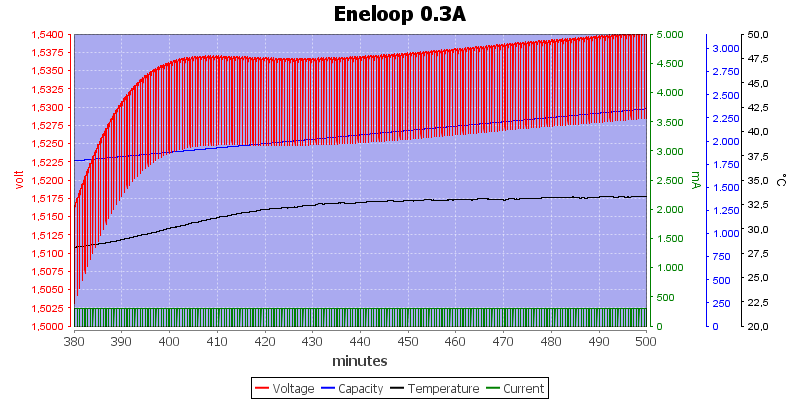
It is possible to see the voltage peak with current on, but not really with current off. The drop is maybe 0.2mV, not a good signal to terminate on and if you wait to long the voltage start increasing again.
With this cell and this current it is basically impossible to do -dv/dt termination, but a 0dv/dt termination would work fine.
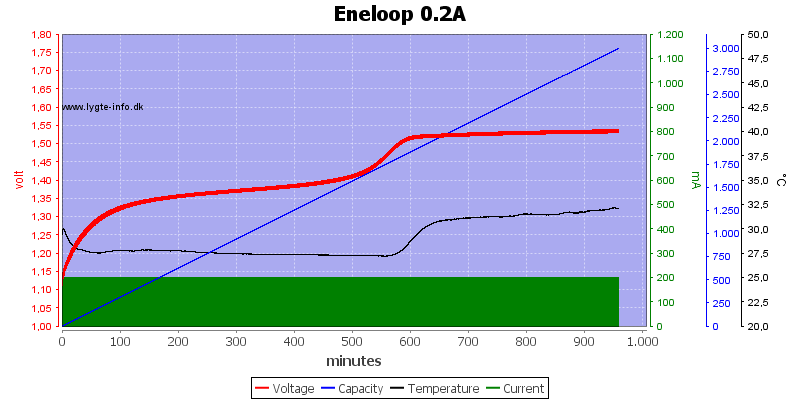
Going down to 0.2A makes it completely hopeless to use -dv/dt termination.
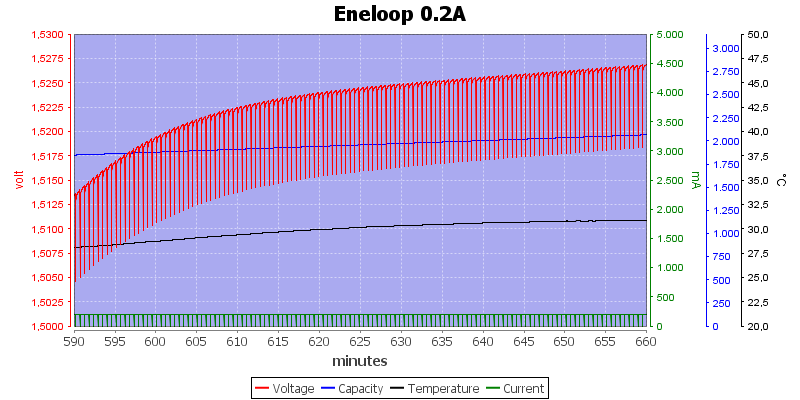
Even when zooming in there is no drop or steady voltage, a 0dv/dt would not work either
The conclusion of the above must be to never use a low current on a -dv/dt charger, the general recommendation is never to go below 0.3C, that would be 0.6A for this cell. That looks reasonable enough, but I will prefer 0.5C or 1A, it has a much better termination signal. Using a charger that also has 0dv/dt termination would get around some of this problem.
A close look at voltage termination
Voltage termination will stop charging during the final voltage raise.

It is best if it is just before the maximum to get as much capacity from the battery as possible, but there are a few problems with that.
If the termination voltage is too high, the charger will miss termination, then the only hope is that the charger has a backup termination (time).
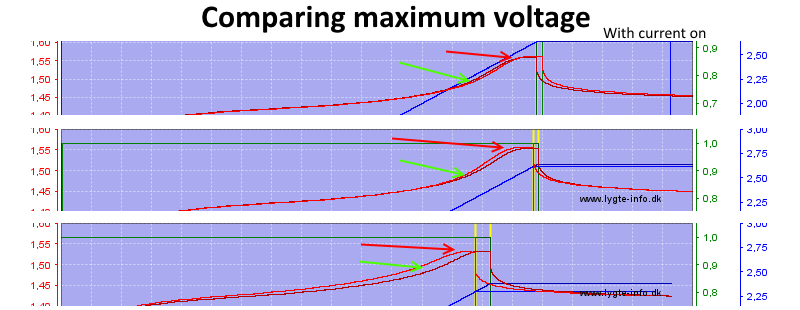
But the maximum voltage varies between batteries, here I have compared 3 different cells where the voltage varies from about 1.53 to 1.56 volt. This might not sound as much variation, but look at the green arrows, I would not like termination before that and it is at about 1.50 volt. This does not leave much room for a good voltage termination (Remember these values are with charge current on).

This table shows the voltage at different charge currents when the full capacity has been charged into the cell and also 10% before full capacity has been charged into the cell.
The maximum voltage does vary with current, I have made the above table based on my test. The time column matches the point in the curves where I have picked the values (Within 30 seconds, I had to find the next current off). To get the most capacity from the batteries you want the termination just below the maximum voltage, if it terminates at the 10% voltage you will have lost 10% of the batteries capacity due to the charging.
With current off the maximum voltage varies from 1.50 to 1.56 volt, depending on charge current and the "too early" termination varies from 1.46 volt to 1.50 volt. With different charge current there is not really a perfect voltage for termination, even with a single type of cell.
The maximum voltage will also vary with temperature, but I have not tested that.
How do chargers handle this? Often they have a termination about 1.48 volt with current off and then uses a top-off charge, i.e. they will charge a fixed amount more into the cell after termination. This is done at a lower current to avoid heating the cell. Another solution is to use a high trickle charger, but that is not good for the batteries if they stay in the charger.
Usual chargers will report ready when they reach the voltage termination, the extra current is done "secretly".
Termination vs. capacity
How important is correct termination for the capacity, I decided to do a test.
In all the testing I have one hour rest between charge and discharge.
For this test I used a new Fujitsu 2000mAh AA cell (This is same cell as eneloop).
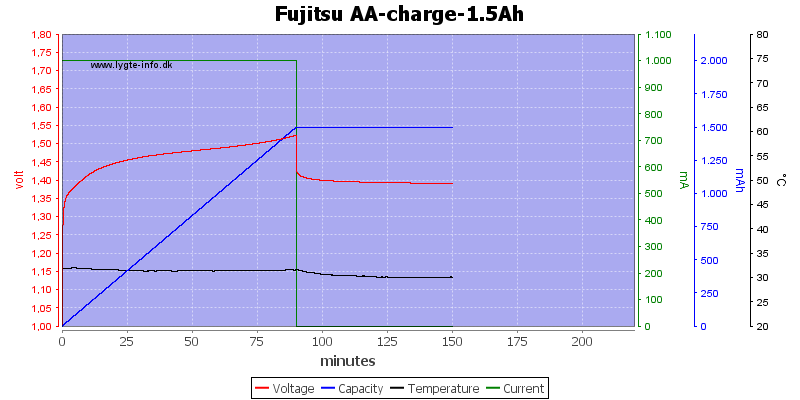
This is one of my normal charge curves, except I stopped a bit premature. Lets look at it another way:
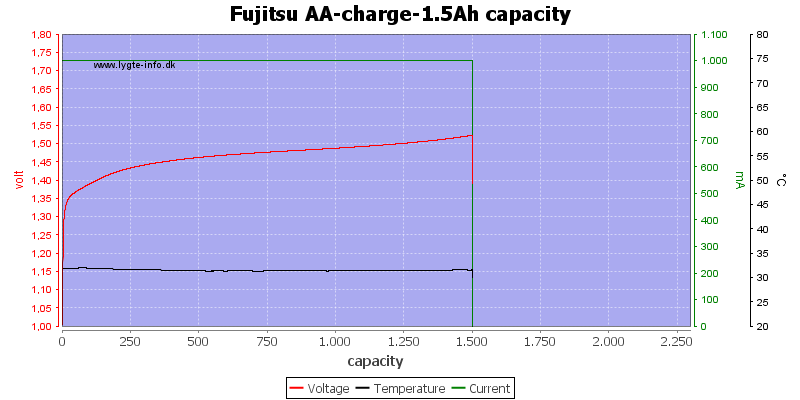
Changing from time to capacity scale makes it obvious that I filled 1500mAh into the cell, when I discharged this cell I measured 1496mAh.
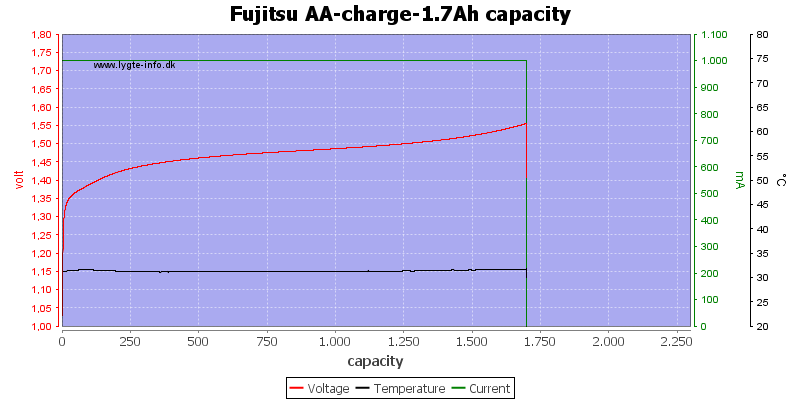

I did a couple more with different capacity.
In fact, I did many more and also discharged the battery after each one to measure the actual capacity charged into the battery

This is the last one where I charged 2300mAh into the battery and it could deliver 1917mAh when discharged.
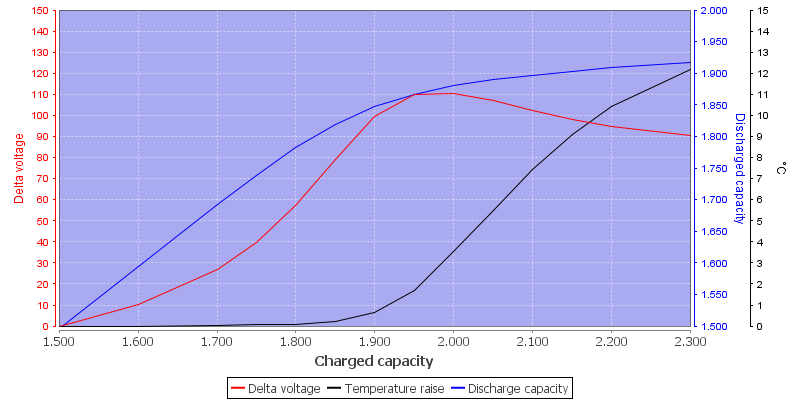
To see the result I plotted charged and discharge capacity into a chart and also added relative voltage and temperature (Both taken from the last curve).
I use "Delta voltage" to get smaller numbers, it is just voltage above 1.50 volt.
Up to about 1900mAh there is very small loses in charge/discharge process, but trying to get the full capacity means some loses and these loses are converted to heat.
Looking at this curve a -dv/dt termination a bit above 2000mAh charged capacity looks very nice and the battery will have about 1880mAh.
A voltage termination will probably stop between 1800 and 1900mAh charged capacity and the discharge capacity will be between 1780mAh and 1840mAh.
The difference is not huge, but to get full capacity you either need:
A -dv/dt termination charger.
A voltage termination charge with top-off charging.
DMM's and chargers with voltage readout
The voltage readout on a charger will seldom match a DMM that is used to measure the voltage simultaneous with the charging. There is a very good reason for that.
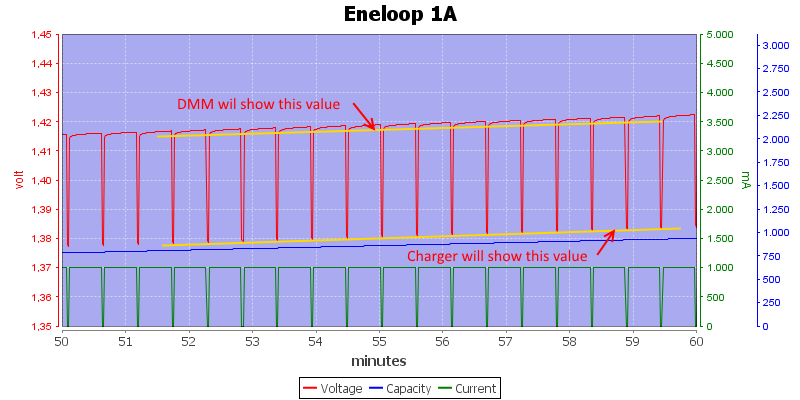
The charger will usual turn the current off to measure the voltage, but the DMM will measure the average battery voltage.
The best way to compare the meters is if the charger can show voltage without charging (or discharging), this may be possible at the start of a charge or end of charge.
If that is impossible the only solution is to select the lowest possible charge current, then the DMM and the charger will be fairly close, but the DMM is supposed to show a little bit to high.
If done during discharge the DMM will show a little bit lower value than the charger.
Conclusion
To get a good charger look for one with individual cell termination, i.e. it must be able to charger one cell at a time. It must terminate when the battery is full and preferable not use trickle charge. For chargers with voltage termination a top-off charge is acceptable and secures that the cell is full, for chargers with -dv/dt termination it is not needed.
Keeping the batteries cool during charge is also a good idea, i.e. using a charger that heats batteries as little as possible.
If the current is selectable, it must be high enough to enable -dv/dt termination on -dv/dt charges, i.e. 0.5A for AAA and 1A for AA is fine.
Notes
The voltages measured in this article will not be valid for all NiMH batteries, because the voltage will vary with cell age, temperature and chemistry.
My charger reviews

%20%231.png)

%2012.png)

%20%231.png)

%20%231.png)

-Charge.png)
%20%231.png)

.png)

.png)

%20%231.png)





















